 |
 |
 |
 |
 |
 |
| |
 |
|
 |
 |
 |
  |
  |
 |
 |
 |
 |
|
|
 |
|
 |
 |
 |
BUILDING |
 |
|
 |
|
 |
 |
 |
| |
 |
| 
 |
Astana National Library
|
|
 |
 |
 |
 |
DESIGNER |
 |
|
|
 |
|
 |
 |
 |
| |
 |
|
 |
 |
 |
 |
DESCRIPTION |
 |
|
|
 |
|
 |
 |
 |
|
|
 |
The National Library is conceived as the integration of 4 organizational strategies into one new national institution
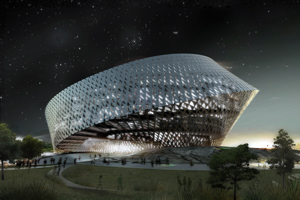 The perfect circle of the national archives The perfect circle of the national archives
The orbiting spiral of the public spaces
The complex geometry of the Möbius envelope
and the radially distributed section of the Kazakh landscape
The pure diagram of the circle combined with the meandering trajectory of the public path creates an institution that is rigorous and playful, crystal clear and serendipitous. The eager student, the focused researcher, the citizen pilgrim and the curious tourist will all find an institution that meets their needs.
The Architecture of the National Library fuses 4 universal archetypes into one new national monument
The circle, the rotunda, the arch and the yurt are merged in the form of a Möbius strip. The clarity of the circle, the courtyard of the rotunda, the gateway of the arch and the soft silhouette of the yurt are combined to create a new national monument appearing local and universal, contemporary and timeless, unique and archetypal at the same time. |
|
 |
 |
 |
|
 |
|
| Nation building |
 |
|
 |
 To design the Foundation and Library of the First President of the Republic of Kazakhstan is more than a common architectural challenge. The National Library will be one of the cornerstones of Kazakh nation building, and a leading institution representing the Kazakh national identity. The new National Library in Astana shall not only accumulate history but also project new futures for the nation and its new capital. To design the Foundation and Library of the First President of the Republic of Kazakhstan is more than a common architectural challenge. The National Library will be one of the cornerstones of Kazakh nation building, and a leading institution representing the Kazakh national identity. The new National Library in Astana shall not only accumulate history but also project new futures for the nation and its new capital.
It will be an intellectual, multifunctional and cultural center, with a primary goal of reflecting processes of establishment and development of sovereign Kazakhstan, its political history, popularization of life, and the Head of the State’s activities and role in the development of the country.
The National Library will be the place where the citizens of Astana, the people of Kazakhstan as well as international visitors can come to explore the country’s history, its diverse cultures, its new capital and its first president. The Library will accommodate and communicate with all segments of the population: civil servants, politicians, researchers, students, museum historians and staff from other culture institutions, etc.
The park around the library is designed like a living library of trees, plants, minerals and rocks allowing visitors to experience a cross section of Kazakhstan’s natural landscape, and personally experience the capital’s transition across the country from Almaty to Astana.
In the library they will be able to study the history of the Kazakh culture and language present in the massive collection of books, magazines, film and other media.
Visitors of the museum will be able to follow the creation of the new capital city of Astana from its foundation through its ongoing evolution. Exhibitions of drawings, images and models along with a 360 degree panoramic overview of the surrounding city will give visitors a glimpse into the past, present and future of the city.
Finally museum visitors will be able to learn about the independent republic’s first president: his past, present role and future legacy. From childhood to present day, visitors will follow his personal life story in parallel with that of the country’s recent development from Soviet state to independent democracy. |
|
 |
 |
 |
|
 |
|
| Knowledge production, storage and distribution |
 |
|
 |
The Kazakh National Library will be the place of storing, organizing, distributing and creating new knowledge of the Kazakh culture. Both archive and museum, the National Library will be a place for work and study, as well as education and tourism. A place for progress and a place for pleasure.
As a national concentration of knowledge about the Kazakh culture and history, geography and demographics, government and presidency - The National Library will be a place for the people to learn about the president, as well as a forum for the president to meet with the people.
 1 National library collection 1 National library collection
– what is a library but an efficient archive of books
2 Public spaces
…. And a path for the public to reach them.
3 Linear library
The simplest organizational form would be a linear grouping of knowledge allowing librarians to archive all the collections according to a rational indexing system like the Dewy Decimal System from 000 to 999. The drawback of the linear organization is that it is dominated by dead ends and poor spatial quality.
4 Perfect circle
The archive is organized as a circular loop of knowledge, surrounded by light and air on both sides. On the periphery a 360 degree panorama of Astana - at the heart of the building a contemplative courtyard domed by the heavenly light blue of the celestial vault.
The simplicity and perfection of the infinite circle allows for a crystal clear and intuitive orientation in the vast and growing collection that will populate the shelves of the National Library.
So how does the public access this perfect circular archive?
5 Envelopment
Pros and Cons
+By wrapping the circular library in public programs,internal connectivity is optimized. Each individual program gains direct access to the collection as well as a panoramic view of the surrounding city.
6 Lining
+Lining the circle along the interior with a ring of public programs provides and accessible cluster of communal spaces for meeting rooms and auditoriums.
- While perfect for collective activities and conferences, the interiority could feel claustrophobic and isolated from the surrounding city.
7 Podium
+Lifting the circle up onto a podium of public programs, lobbies, etc ensures a solid integration with the surrounding public spaces and park,
However, this stacking effect loses the benefits of direct relationships with the collections as well as the experience of panoramic overview from above
8 Overview
+/- By reversely placing all the public functions on top of the circular podium of the library we will have the full panorama at the expense of integration with the surroundings.
9 Public Spiral (Inside+outside+above+below)
The ideal addition to the perfect circle will be a series of public programs that simultaneously wraps the library on the outside as well as the inside, above as well as below. By twisting the public program into a continuous spiraling path tracing the library on all sides, we create an architectural organization that combines the virtues of all 4 complimenting models.
Like a Möbius strip, the public programs move seamlessly from the inside to the outside and from ground to the sky providing spectacular views of the surrounding landscape and skyline.
10 Möbius strip
The 2 interlocking structures: the perfect circle and the public spiral, create a building that transforms from a horizontal organization where library museum and support functions are placed next to each other, to a vertical organization where they are stacked on top of each other through a diagonal organization combining vertical hierarchy, horizontal connectivity and diagonal view lines.
By wrapping the transforming composition of spaces with a continuous skin we create a Möbius strip volume where the facades move from inside to outside and back again. Evoking associations to classic geometry as well as modern mathematics, classical forms such as the rotunda and the arch as well as the traditional yurt, the Möbius shape merges the local and the universal, the tradition and the future. |
|
 |
 |
 |
|
 |
|
| Organization |
 |
|
 |
The composition of the circular library and the orbiting spiral loop creates 3 radically different organizations providing the library with the best of all 3
11 Horizontal organization
 All programs, public and private, books and people are placed next to each other with direct shortcuts back and forth. All programs, public and private, books and people are placed next to each other with direct shortcuts back and forth.
12 Vertical organization
The programs are placed on top of each other, allowing the users to have uninterrupted views towards the city and the courtyard, and providing easy security and access control between public and private programs
13 Diagonal organization
Museum, reading rooms, restaurants and book collections are placed diagonally above and below each other allowing direct sightlines, overview and glimpses across spaces, levels and programs. |
|
 |
 |
 |
|
 |
|
| Monument |
 |
|
 |
The design of the National Library of Kazakhstan combines 4 archetypes across space and time into a new national symbol. As well as being both modern and rational the scheme of the library is also anchored in a classical vocabulary of traditional libraries. Just like the ancestor and the reconstructed library in Alexandria we have chosen to use a circular organisation of the inner core. A strong enclosed geometrical shape with a panoptic appearance and a clear organisation.
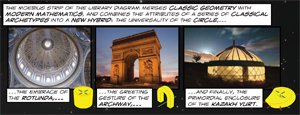 14 Circle (Great Library of Alexandria) 14 Circle (Great Library of Alexandria)
15 Rotunda (some famous round courtyard building?)
16 Arch (Arc de Triomphe)
17 Yurt (a nice yurt)
18 Rotunda + Disk + Archway+Yurt = Möbius strip |
|
 |
 |
 |
|
 |
|
|
|
 |
The program of the National Library of Kazakhstan is resolved through 4 intertwining systems:
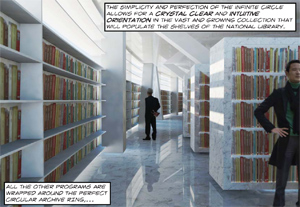 1) An inner circular core containing the Presidential Library’s collections of books, magazines and media. 1) An inner circular core containing the Presidential Library’s collections of books, magazines and media.
The inner circular core containing the Presidential Library’s collections are divided into 42 partitions corresponding to the number of letters in the Kazakh Cyrillic alphabet. The cylinder’s three main decks are, in principle, one integrated space with internal circulation allowing for continuous and intuitive access to all the stored media. Open for any organisation: alphabetical, chronological or decimal the circular library combines maximum flexibility with maximum accessibility.
On all sides, inside and outside, the circular archive intersects with the public programs, reading rooms, study rooms, auditoriums, museum and administration making the library the programmatic as well as spatial heart of the institution.
2) A continuous spiral loop of supporting and additional functions orbiting the circular core.
The looping spiral is divided into two separate systems. A continuous trajectory of supporting and additional functions such as auditoriums, reading rooms, research facilities, administrative offices, meeting- and small conference rooms, a VIP section and the presidential venue. The intertwining spiral allows double high ceiling auditoriums and conference facilities. The stepping structure of the looping spiral provides optimal conditions for sloping auditoriums and combines continuous clarity with spatial variation.
A public path is running off the looping spiral all the way from the bottom to the top of the building circumscribing the cylindrical core inside-out - transforming the void of the double façade system into a continuous atrium visually and spatially connecting all levels. The orbiting structure provides a public pathway with a prominent view of the city and the surrounding park. Visitors can take a tour of the orbiting pathway without physically entering the President’s collection or using the additional facilities. A free entrance to the pathway could turn the library atrium and foyer into an outstanding public interior space directly connected to the park area and embankment outside.
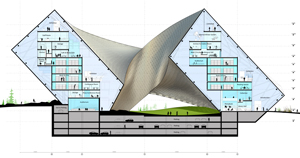 3) A protective skin wrapping the whole structure, creating a mediating space between inside and out. 3) A protective skin wrapping the whole structure, creating a mediating space between inside and out.
The facade wrapping the entire structure is conceived as a double Möbius strip going from vertical to horizontal and back again. The complex skin is, in fact, a ruled surface structured in a very simple and repetitive way using straight sections and triangulated lattices. Photovoltaic tiles on the façade absorb energy from the sun while also providing passive shading. Additionally, air will naturally ventilate between the inner structure’s interior space and the atrium’s naturally regulated climatic comfort zone.
4) A concentric park of ecological systems representing the diversity of the Kazakh landscape and the capital’s transition from Almaty to Astana.
The National Library of cultural artifacts is situated in a geographical and living biological library of Kazakhstan’s landscapes. A cross-section of the Kazakh terrain from south to north, connecting Almaty and Astana, forms the setting of the building. Different vegetation and topographical elements ranging from the Altai Mountain region, Betpak-Dala Desert, and Balkhash Lake in the south, to the Sary-Arka steppes and coniferous forests in the north are distributed around the Library in a radial pattern. Circulation paths are strategically woven throughout to allow for pedestrian access from all edges of the site while also providing every visitor, whether arriving by foot or by car, with complete exposure to the landscape’s diversity. The downscaled mountainous terrain is integrated into the base of the building creating a natural canyon allowing access underneath the cantilevering façade. A visitor taking a tour of the National Library will not only experience the Presidential collection andget a prominent panorama of the new Capital but will also acquire a sense of the range of the Kazakh landscape, flora and fauna. |
|
 |
 |
 |
|
 |
|
| Symbiosis of urbanity and nature |
 |
|
 |
The National Library of Kazakhstan is conceived as a symbiosis of urbanity and nature. Like Astana, which is located in the heart of the Kazakh mainland, the library will be integrated into the heart of a re-created Kazakh landscape.
 The National Library’s collection of manmade media extends outside in the form of a library of trees, plants, minerals and rocks. The Library is like an entire landscape of knowledge and information, inside as well as outside. The National Library’s collection of manmade media extends outside in the form of a library of trees, plants, minerals and rocks. The Library is like an entire landscape of knowledge and information, inside as well as outside.
Continuous surface –
The envelope of The National Library transcends the traditional architectural categories such as wall and roof. Like a yurt the wall becomes the roof, which becomes floor, which becomes the wall again
Pattern as climate screen –
By using state of the art technology and simulation capacity we have calculated the thermal exposure on the building envelope. Due to the warping and twisting geometry the thermal imprint on the façade is continually varying in intensity. The thermal map ranging from blue to red reveals which zones do and do not need shading.
By translating the climatic information into a façade pattern of varying openness we create a form of ecological ornament that regulates the solar impact according to thermal requirements. The result is a contemporary interpretation of the traditional patterns and fabrics from the yurt. Both sustainable and beautiful.
Façade as fabric –
The ruled surface of the Möbius façade evokes notions of sagging fabrics and tensile structures, even though it is generated though a sequence of 42 rectangular cross sections. Modular and organic, soft and rectilinear it combines rational and fast construction with a poetic expression. The library is basically conceived as a contemporary yurt: a cizrcular skeleton sheltered by an ornamental skin. |
|
 |
 |
 |
|
 |
|
| Structure |
 |
|
 |
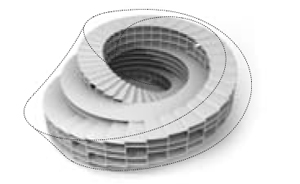 The spiral portion of the library is rectangular in section, made from transverse steel frames 15.5m in height and 14.5m in length. The spiral portion of the library is rectangular in section, made from transverse steel frames 15.5m in height and 14.5m in length.
The frames are arranged radially around the spiral, and are linked by longitudinal beams at each corner. Where the cantilevered sections of spiral move past each other, they are linked by another braced frame to provide shear strength, creating a stiff radial slice.
Longitudinal beams span between the radial frames. The steel decking and concrete then form the composite floor slabs.
Five concrete cores, spaced evenly around the spiral, provide lateral stability and reduce the length of the cantilevers.
The three frames are tied together by a parallelogram-shaped frame. These radial frames are then linked together by diagonal beams to form the diagrid façade. |
|
 |
 |
 |
 |
 |
 |
 |
ECO-SUSTAINABILITY |
 |
|
|
 |
|
 |
 |
 |
| General ecology |
 |
|
 |
Breathable Façade
Façade has the ability to breathe when the climate outside is amenable Any areas requiring close control can be maintained within an inner ‘box’
Intelligent Façade
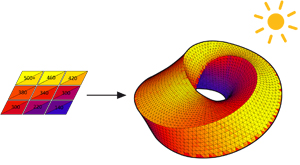 The façade shading design can be used to be part of the artistic expression of the building envelope The façade shading design can be used to be part of the artistic expression of the building envelope
Using knowledge of the annual sunpath the façade can be optimised to provide the maximum ambient light while still protecting from direct solar radiation
The benefit of this means that the Library is kept in natural light, lighting energy is reduced, glare for occupants is minimised and solar loads are reduced.
The façade shading strategy design can be used to be part of the artistic expression of the building envelope
Using knowledge of the annual sunpath the façade can be optimised to provide the maximum ambient light while still protecting from direct solar radiation
The benefit of this means that the Library is kept in natural light, lighting energy is reduced, glare for occupants is minimised and solar loads are reduced.
The façade shading strategy design can be used to be part of the artistic expression of the building envelope. |
|
 |
 |
 |
 |
 |
 |
 |
LOCATION |
 |
|
|
 |
|
 |
 |
 |

|
 |

|
Continent |
|
 |
  Asia |
|
Nation |
|
 |
  Kazakhstan [Qazaqstan] |
|
Province |
|
 |
  Aqmola |
|
Town |
|
 |
  Astana |
|
Address |
|
 |
  The Left Quay
|
|
|
|
 |
|
 |
 |
 |
 |
MAP |
 |
|
|
 |
|
 |
 |
 |
| |
 |
|
 |
 |
 |
 |
|
TYPOLOGY |
 |
|
|
 |
|
 |
 |
 |
|
|
 |
ARCHITECTURE | Buildings for cultural activities
Libraries and media libraries
| |
 |
 |
 |
 |
CHRONOLOGY |
 |
|
|
 |
|
 |
 |
 |
Project |
 |
|
 |
| 
 |
2009
project winner of competition
|
|
Realisation |
 |
|
 |
| 
 |
2012 |
|
 |
 |
 |
 |
BIBILIOGRAPHIC REFERENCES |
 |
|
|
 |
|
 |
 |
 |
|
 |
| "Astana National Library, Astana, Kazakhstan. BIG", GA Document 113, july 2010 [International 2010], pp. 144-151 |
|
|
| "Astana National Library, Kazakhstan", Arkitektur DK 6/09, november-december 2009 [The BIG Lab], pp. 22-29 (1-63) |
|
 |
 |
 |
 |
 |
 |
 |
CLIENT |
 |
|
|
 |
|
 |
 |
 |
| |
 |
| Kazakhstan Presidential Office |
|
 |
 |
 |
 |
DIMENSIONAL
DATA |
 |
|
|
 |
|
 |
 |
 |
| Surface |
 |
|
 |
|
 |
 |
 |
 |
CREDITS |
 |
|
|
 |
|
 |
 |
 |
| |
 |
Drawings © BIG Bjarke Ingels Group
Text edited by BIG Bjarke Ingels Group
Courtesy by BIG Bjarke Ingels Group
|
|
 |
  |
 |
|
|